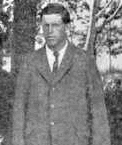 Harmon changed countless lives of those who came in contact with him either as the products of his missionary work or during his one furlough back to the United States the year before he died. Harmon changed countless lives of those who came in contact with him either as the products of his missionary work or during his one furlough back to the United States the year before he died.
The action in his story really begins at age twelve. He and his brother and sister were orphaned and Harmon was forced to work at making pottery. Because of his need to work, he eventually had to quit school. But, as he grew older, he felt the call of God to missionary work. So, he made his way to a school in northeast Texas called Peniel University (the forerunner of what is today Southern Nazarene University). Schmelzenbach held his call to Africa from everyone until he could no longer hide his fire. President E. P. Ellyson helped him get financial funding for five years. So, on May 5, 1907, Harmon and nine other missionaries set off for Africa. On June 19, 1908, Harmon married Lula Glatzel, one of the other missionaries from Peniel. They began working on learning the language of the Zulus and witnessing to them. In April 1908, they were accepted as Nazarene missionaries, they had already decided to focus their work in Swaziland. Their ministry in Swaziland did not begin smoothly and they were not initially accepted by the Swazi people. It was the winter of 1911 before they were able to move into a permanent residence because the Queen had made a vow not to let any white person to take up residency in her country. At one point a group of warriors were even given orders to kill the Schmelzenbachs. A breakthrough finally did come and the people of Swaziland ultimately fell in love with Harmon Schmelzenbach. His work began to take root throughout the country. As people turned from the darkness and came to Christ in increasing numbers, Harmon used his own money and built churches throughout the land. As he built more churches, he had to train more preachers. As he trained more preachers, he had to have better housing for them. The demands on Schmelzenbach continued throughout the years. He also had to face the loss of some of his children and deal with his own declining health. The people that he loved prayed for him. He would get well and continue on with his work. Though his overall health decreased with the passing of the years, his drive and desire to save the people of Swaziland increased. In all the years, he never gave up. He continued to go to wherever people would listen. His dream for Africa was larger and greater than he could ever have accomplished in his life. The great hope he had for his adopted people led him to pave the way for many fields in Africa and for the missionaries who followed in his footsteps. On May 22, 1929, Harmon Schmelzenbach died with his adopted people. <information from http://home.snu.edu/~hculbert/schmel.htm>
|